The Tokyo Olympics will be the strangest Games on record.
No fans in the crowd, no cheering allowed, an Olympic village devoid of its usual boisterous energy, and a host city under a state-of-emergency because of COVID-19 infections – Tokyo will be unlike any previous Games.
Here, we will collect behind-the-scenes moments – the odd, offbeat and heartfelt moments – from our reporters on the ground at the Summer Games.
Day 10 in Tokyo
Nathan VanderKlippe, U.S. correspondent
Cheerleading the state is one of the main functions of China’s propaganda press. It’s less often that it actually leads cheers.
At the Olympics, though, Chinese journalists have made press tribunes into applause booths. They clapped after every plunge as China extended its unbeaten streak at women’s diving. They joined in shouting “Wang Zhouyu, jiayou” then cheered as that weightlifter walked away with gold.
Nationalism is the Olympics stock in trade, and Chinese journalists are not alone in rooting for the home team. The entire Games media apparatus is built to serve the interests of narrow hometown reporting. Journalists are identified by nationality, and it is often impossible to get access to events if an athlete under the same flag is not competing.
And China has had plenty to cheer at these Olympics. In some events — like diving and weightlifting — Chinese competitors are so dominant that the rest of the field plays for, at best, second place. On Monday, it wasn’t until every other competitor had finished that weightlifter Li Wenwen appeared for her first clean and jerk. She set Olympic records in both snatch and clean-and-jerk in the 87-plus kilogram category.
Tokyo 2020 Olympics - Weightlifting - Women's +87kg - Group A - Tokyo International Forum, Tokyo, Japan - August 2, 2021. Li Wenwen of China in action.EDGARD GARRIDO/Reuters
Chinese athletes, many built into champions by a system that blends Soviet-style talent development with artificial intelligence smarts, have turned in an Olympics performance any aspiring superpower would lust for.
China currently sits atop the medal table with 29 golds and 62 total medals. The U.S. trails with 22 golds and 64 total.
Since 1996, the U.S. has only once finished second-place in an Olympic medal table. That was in 2008, at the Beijing Games. If China can maintain its lead, it will mark the country’s first overseas Olympics as national victors. Few things would make the country’s leadership happier, barely a month after a 100th anniversary party for the Communist Party in which president Xi Jinping brought new resolve to the country’s bid for global supremacy.
“Chinese people will never allow foreign bullying, oppressing, or subjugating,” Mr. Xi said in July.
China’s athletes have taken that mandate straight to Japan. This week, Zhong Tianshi and Bao Shanju wore Mao Zedong pins to the medal ceremony after winning gold in cycling track team sprint. Critics have called for an investigation into the politicization of a medal ceremony, and athletes from other countries have raised alarm over the outpouring of nasty online comments from internet trolls after Chinese losses.
Tokyo 2020 Olympics - Cycling - Track - Women's Team Sprint - Medal Ceremony - Izu Velodrome, Shizuoka, Japan - August 2, 2021. Gold medallists Bao Shanju of China and Zhong Tianshi of China wearing protective face masks pose with badges of the late Chinese chairman Mao Zedong pinned to their tracksuits.MATTHEW CHILDS/Reuters
None of that has dimmed the ardour for country among China’s athletes.
In a year of centenary celebrations for the Communist Party, “I’m happy to come back with this gift,” shot-putter Gong Lijiao said after securing China’s first Tokyo Games athletics gold.
“This kind of power is given by the people of the motherland,” Wang Shun said after winning gold in the men’s 200m individual swimming medley, where he set an Asian record. “I did what I said before the Games, I let the national flag flutter in Tokyo, and let the national anthem play in Tokyo.”
Day 9 in Tokyo
Rachel Brady, sports reporter
The day started on a 7 a.m. bus to the pool. I was too early to hit our hotel breakfast, and I couldn’t eat anyway since I needed to do a saliva test for COVID-19 – a mandatory thing for all Olympic participants and media here in Tokyo. There’s no eating, drinking or brushing your teeth within 30 minutes of a saliva test, so you’ve got to carefully work it into your morning.
Media can’t ride public transportation or walk to venues in Tokyo until they’ve been here 14 days, so we rely on special Games buses, all going through a complicated bus mall at the main press centre. Some days here, I’ve spent upwards of four total hours on buses, much of that writing with laptop in lap.
Because track and field and swimming are both premium events at an Olympics, reporters and photographers have to apply for special press tickets for finals – only a certain number per country are awarded.
It was my fourth straight morning at swimming – the last day for that meet -- so I watched a slew of Olympic records set and medals awarded. Relays have been the most exciting – watching Canadian teammates Kylie Masse, Sydney Pickrem and Maggie MacNeil intensely watch Penny Oleksiak swim the anchor leg will be one of my lasting images from these Games. As she finished the race, we could see Masse yelled something to Oleksiak. Masse later told us she hollered “most decorated”, as the team helped Oleksiak seal up her seventh medal, making her Canada’s most decorated Olympian ever.
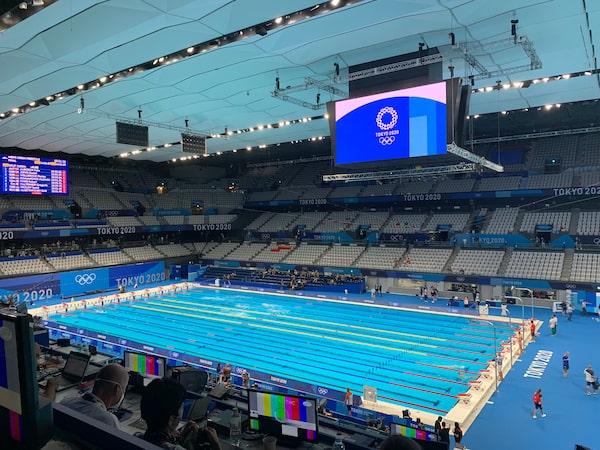
Photos by Rachel Brady.Rachel Brady/Handout
We waited a long while for the four women to come chat with us after they received their medals. They had arms wrapped tightly around one other the entire time. A couple of us grabbed a quick curry meal from the media concession stand to eat on our next bus ride.
Getting from the swimming venue to Olympic Stadium for the men’s 100-metre final is a time-consuming trip – back through the main media bus mall then a transfer to another bus. It was jarring to see so many people on the streets around the stadium – a busy shopping area -- yet no fans permitted inside.
My seat in the press tribune was incredible – the first level, right about the 50-meter mark where the race would take place. It was so humid – some 33C, so we were sweating as much as we were writing.
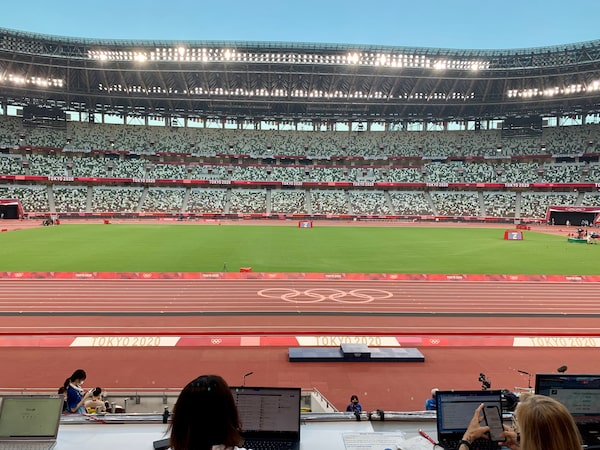
Photos by Rachel Brady.Rachel Brady/Handout
Athletes must walk through an interview space called the mixed zone after they compete, and De Grasse showed up still with the Canadian flag draped around his shoulders, racing glasses atop his head. It’s interesting to watch large groups of reporters from different countries surround their sprinter – Chinese, Italians, Americans.
We got back to our hotel around 1 a.m., and this time I couldn’t keep my eyes open on the bus.
Nathan VanderKlippe, U.S. correspondent
Olympic gold-medal performances, in many ways are all alike: triumphs of athleticism and artistic perfection. It is the failures that are each different in their own ways.
For Jennifer Abel, it was the third dive, the reverse two-and-a-half piked, the bete noire of a career that has cemented her as one of Canada’s greatest divers. Often, her takeoff is imperfect. She compensates in the air.
On Sunday, in a medal round that is likely her last at the Olympics, she was bedevilled by unexpected perfection.
She managed what she called a “good takeoff.” When she then adjusted for the flawed start she had expected, she spoiled the dive.
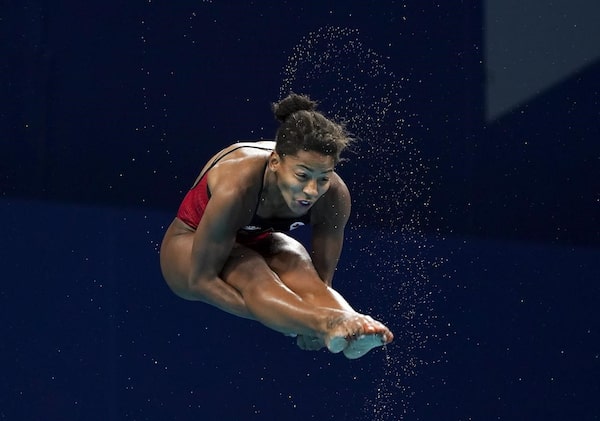
Jennifer Abel of Canada competes in the Women's 3m Springboard final during the summer Tokyo Olympics in Tokyo, Japan on Sunday, August 1, 2021.The Canadian Press
“When she took off, with what we would consider almost ideal circumstances, she just wasn’t prepared for the timing of the whole thing,” said Mitch Geller, chief technical director of Swimming Canada. Abel scored 39, her worst dive at these Olympics.
She finished eighth.
Medals went to Chinese divers Wang Han and Shi Tingmao, followed by Krysta Palmer, an American.
Five years ago in Rio de Janeiro, Abel was crushed by fourth-place finishes in the individual and synchronized three-metre springboard. On Sunday, however, she emerged from the pool smiling and blowing kisses at the camera.
Her poor finish was leavened by her earlier success, a silver medal in the synchronized event with partner Melissa Citrini-Beaulieu.
But where in Rio she had felt shame, in Tokyo she felt a sense of accomplishment. Had she finished eighth at the last Olympics, “I would have been even harder on myself,” she said.
Failure has been a good, if difficult teacher.
“When you look at the bigger picture, everybody dreams to be here,” she said Sunday. There was pride in finishing “with a smile even though if I missed. And I think that’s the beauty of sports. It’s to be able to come back and not be too rough on yourself even though you missed.”
Melissa Tait, visual journalist
Day 8 in Tokyo
Melissa Tait, visual journalist
Day 7 in Tokyo
Melissa Tait, visual journalist
Day 6 in Tokyo
Melissa Tait, visual journalist
Nathan VanderKlippe, U.S. correspondent
Canada’s Caileigh Filmer calls it “going internal.”
“It means I wasn’t going to look out and I didn’t care what other crews were doing,” she said Thursday, after winning a bronze medal in the women’s rowing pair final with Hillary Janssens. New Zealand and Russia took gold and silver, respectively.
The two Canadians spent the race deliberately with their heads down, executing their strokes, battling physics and the water. “Our plan was just get out fast, be internal. I told Hill I wasn’t even going to call off another crew until we were halfway,” Filmer said. She did the same for the final 500 metres of the 2,000-metre race.
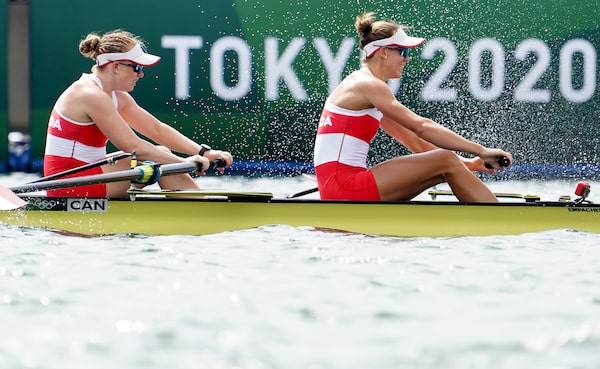
Canada's Caileigh Filmer, left, and Hillary Janssens compete in the women's pair rowing final event during the Tokyo Olympics.Nathan Denette/The Canadian Press
“I told Hill we’re going internal, and we just wanted to trust each other.”
It’s not a bad metaphor for the Tokyo Olympics, a Games driven inward by the pandemic. No outside spectators can come in. No athletes can go out, or even remain in Japan more than a day or two beyond their event.
It’s not a bad description, either, of the isolation the pandemic imposed on athletes, most of whom prepared for these Olympics in a kind of athletic seclusion. Rowers went years without an international race, arriving in Japan nervous and uncertain of where they stood.
“I guarantee you no one else has spent more time on spin bikes this year than us,” Janssens said.
“We have done our time with injuries. And mentally, it’s really tough to believe it in the middle of winter when you’re trying to build fitness and you don’t even know if it will pay off at the end.”
She spoke with a bronze medal draped around her neck.
“To have this makes it worth it,” she said.
Day 5 in Tokyo
Melissa Tait, visual journalist
Penny Oleksiak is now the most decorated Canadian athlete at the Olympic Summer Games after winning her sixth medal - the bronze in the women's 200m freestyle at the Tokyo Olympics. Oleksiak is 21. #tokyo2020 https://t.co/wtAcH9EqnU pic.twitter.com/OqULkPADl0
— 🚀Melissa Tait (@meltait) July 28, 2021
Rachel Brady, sports reporter
While covering judo this week in Tokyo at the iconic Nippon Budokan, I watched from my press tribune seat as a very efficient team change out the competition mats at the venue between the daytime and nighttime sessions, and it was fascinating.
During the elimination rounds during the day, it is a large surface where two fights can be held at the same time – one men’s and one women’s. At night, as fewer judokas remain in the competition, they transform the venue completely to one showcase mat. Suddenly the crew of dozens starts picking up coloured pieces as if from a puzzle, and the whole surface takes a new look. They fit together seamlessly. This made for a fun diversion on a busy day of writing.
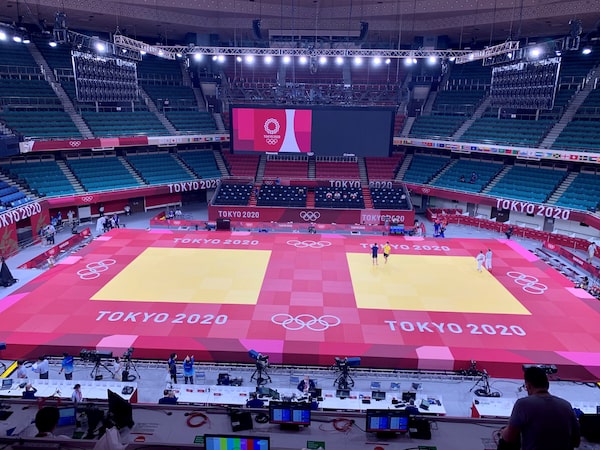
By Rachel Brady, The Globe and MailThe Globe and Mail
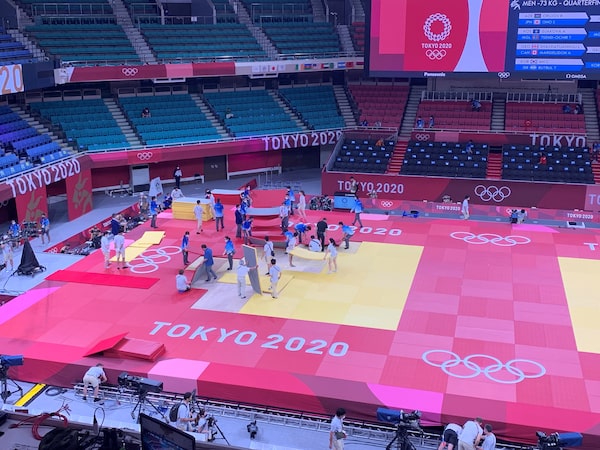
The Globe and Mail
Day 4 in Tokyo
Day 3 in Tokyo
Nathan VanderKlippe, U.S. correspondent
Olympic glory is fleeting at the best of times. But Canadian swimmer Kylie Masse hadn’t yet caught her breath in the time it took her to set an Olympic record – and then lose it, twice. In 100-metre backstroke heats Sunday, Masse set a record with 58.17 seconds, only to have it eclipsed in the very next heat by U.S. swimmer Regan Smith, with 57.96 seconds – and then again a moment later by Australia’s Kaylee McKeown, with 57.88 seconds.
Kylie Masse of Canada in action at the women's 100-metre backstroke.KAI PFAFFENBACH/Reuters
“The Olympic record is amazing and I’m super happy to have achieved that for one or two minutes or however long it was,” Masse said. “But it all comes down to the final,” which is scheduled for Tuesday.
Day 2 in Tokyo
Nathan VanderKlippe, U.S. correspondent
Dogged by scandal, unwanted by a hostile public, saddled with a pandemic and empty seats: this has been the narrative of the Tokyo Games. But the Japanese public, it turns out, remains broadly interested in the Olympics on their soil. Nearly as many people tuned into the opening ceremony this year as did the 1964 Games, which were a landmark in modern Japanese history.
The television audience for the opening ceremony, according to data provided to The Globe and Mail by measurement company Video Research:
- Tokyo 2020: 56.4 percent of households with televisions in the Kanto area, where Tokyo is situated
- Tokyo 1964: 61.2 percent of households
The Olympics are nothing if not deferential to Chinese sensitivities. The International Olympic Committee denies Taiwan, which Beijing claims as its own, the right to use its own name or emblem. Instead, Taiwan – a self-governed nation – appears at the Olympics as Chinese Taipei and is represented by a special flag.
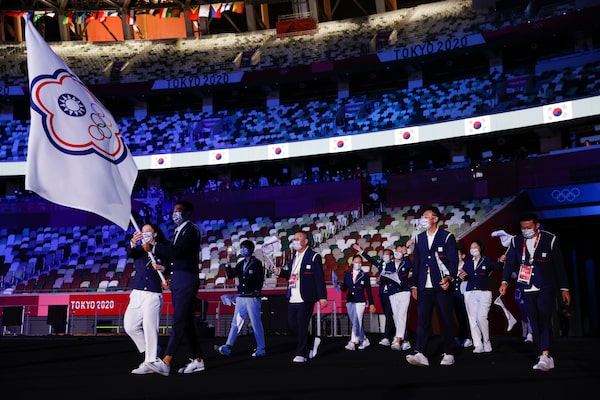
Flag bearers Hsing-Chun Kuo and Yen-Hsun Lu of Team Chinese Taipei during the Opening Ceremony of the Tokyo Olympic Games at Olympic Stadium.Jamie Squire/Getty Images
Even then, China’s nervous online gatekeepers – who operate in a constant state of panic that they might let past something that provokes official ire – were pushed into action by the sight of the Taiwanese team at the opening ceremony Friday. Tencent, the online streaming giant that carries the NHL among other Western sports, interrupted the parade of nations to ensure it kept Chinese viewers safe from the sight of Taiwanese athletes. It broadcast comedy programming instead of the team’s entrance.
But if the idea was to placate a nationalist public, it backfired when the censorship lasted too long, accidentally covering up part of the Chinese team’s entrance as well. Online viewers were not pleased.
Day 2 in Tokyo: Michael Woods was milliseconds away from podium finish in thrilling road race
The angriest parts of the Chinese press, meanwhile, stewed about an NBC commentator urging viewers “not to forget Hong Kong and Xinjiang.” Beijing is the next Olympics host and its human rights record is a major issue for the Winter Games. The Chinese Consul-General in New York issued a statement condemning NBC for broadcasting a “wrong map” that showed Taiwan in a different colour from mainland China. “Politicizing sports and violating the Olympics charter spirits will only do harm,” the Consul-General wrote on Twitter. Chinese commentators, meanwhile, urged reprisals against Japanese broadcaster NHK for uttering the word “Taiwan.”
China nonetheless staged a strong start in the geopolitical Olympics, notching the first gold medal of the Games in 10-metre air rifle and giving the nationalists something to smile about once again.
Day 1 in Tokyo
Melissa Tait, Globe and Mail photographer
Aside from the empty seats and quiet clapping, a moment that will stick with me from the muted opening ceremony was realizing the tiny contingent of Canadian athletes who’d been looping around the stadium were continuing right out the exit.
Tokyo Olympics: Canada’s Humana-Paredes, Pavan win first beach volleyball match 2-0
They stopped briefly to take selfies, with a few staying behind to represent Canada at the beginning of this strange Olympics.
Flagbearers rugby sevens co-captain Nathan Hirayama, left, and basketball player Miranda Ayimin carry the Canadian flag into an empty Olympic Stadium at the opening ceremony of the Tokyo Olympics.Melissa Tait/The Globe and Mail
After about 30 Canadian athletes entered the Olympic Stadium, just a small group stayed inside as the parade of athletes continued. Owing to COVID-19, spectators were banned from the stadium.Melissa Tait/The Globe and Mail
A small group of Canadian athlete stayed inside the stadium.Melissa Tait/The Globe and Mail
Day 0 in Tokyo
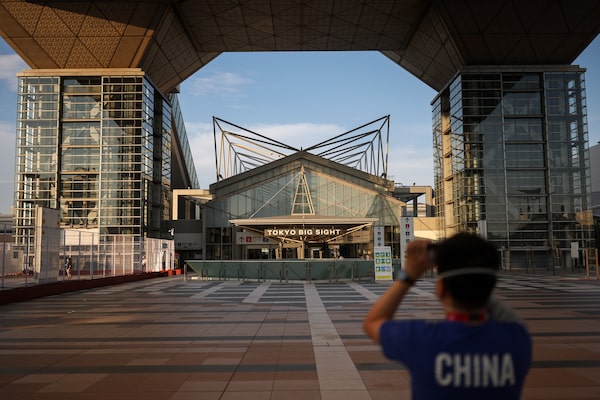
The entrance to the Tokyo Big Sight, the largest convention centre in Japan where the press centre is housed for the Tokyo Olympics. On July 22 – one day before the opening ceremony – it seemed quieter than expected, and by the end of the day was practically empty.Melissa Tait/The Globe and Mail
Melissa Tait
The first day I spent in Japan preparing for what has to be the strangest Olympics of modern times was about 300 times less hectic than I’d imagined.
The lead-up to the Olympics was full of spreadsheets and PDFs about COVID-19 predeparture requirements. We were full of confusion and anxieties over co-ordinating where our team would get tested in Canada, setting up health monitoring apps, and ordering test kits for when we were actually in Tokyo. It’s been intense. I half expected crowds of people to be running past, each person clutching bundles of test kits and yelling about being locked out of an infection control system once we arrived at the main press centre.
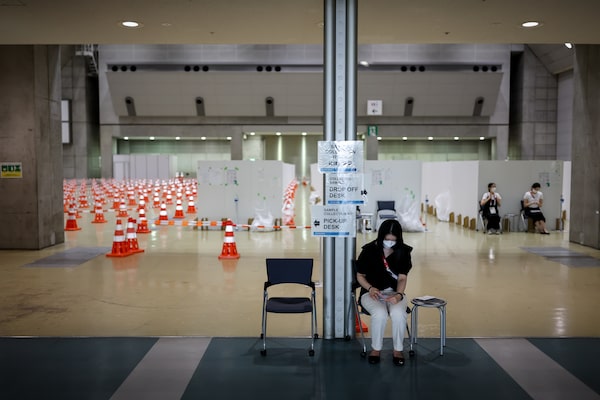
Staff wait to direct press members to COVID-19 testing inside the press centre.Melissa Tait/The Globe and Mail
Instead, the testing area was nearly empty. For much of the day the entire centre seemed empty. So quiet. I haven’t been to a press centre at the Olympics before, but after experiences at other major sporting events, I expected a lot more yelling and running around. I’m really hoping this is good foreshadowing for the rest of the Games.
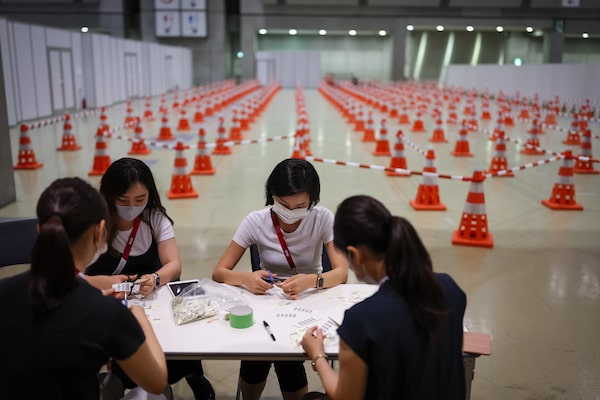
Staff prepare vials for COVID-19 testing kits at the Tokyo Olympics. The space appears to be ready for lines, but was empty for most of the day.Melissa Tait/The Globe and Mail
Sign up for The Globe’s Olympic newsletter and follow all of the news, features and opinion in the lead-up to the Summer Games in Tokyo.